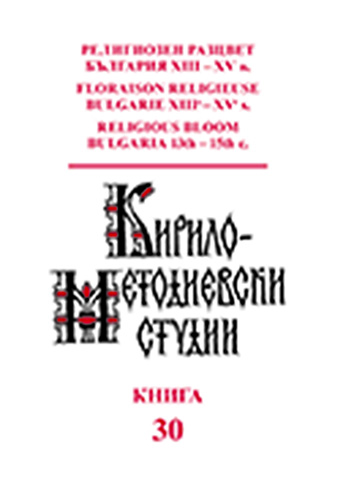Пандектите на Никон Черногорец и монашеските сборници от XIV в.
Pandectae of Nikon of the Black Mountain and monastic miscellanies from the 14th century
Author(s): Desislava NaydenovaSubject(s): Language studies, Language and Literature Studies
Published by: Кирило-Методиевски научен център при Българска академия на науките
Keywords: Pseudo-Zonaras nomocanon; Pandectae; Euthymius; miscellany.
Summary/Abstract: The article aims at analyzing the inclusion of parts of Nikon of the Black Mountain’s Pandectae in certain monastic miscellanies dating from the 14th c. Ms. 1160 from the Church Historical and Archive Institute in Sofia is presented as a case study in the broader context of recent research of the canonical compendium known among slavicists as Pseudo-Zonaras Nomocanon. The comparison of ms. 1160 with the later South Slavic, Moldavian and East Slavic witnesses leads to conclusion that it represents the features of one of the earliest redactions of the Pseudo-Zonaras Nomocanon, in which additional texts have been appended to the main corpus of rules. Author offers an attempt to identify the sources of these new additions as it follows: 1) the Slavonic text of the Credo in its third redaction, which is part of the Epistle to kir Petros, abbot of St. Symeon Thaumatourgus church, which is found alongside with the Preface in the beginning of the second translation of the Pandectae in its “Euthymius” version; 2) part of chapter 57 of the Pandectae. Particular attention is drawn to the fact that these additions to the Pseudo-Zonaras Nomocanon form an integral textual unit and that they are found in several monastic miscellanies such as BAS, Sofia, № 80 (Ryapov sbornik, 14th c.), Dechani monastery № 75 (a miscellany from 1360-1370), Hilandar monastery № 464 (15th c.), GIM, Moscow, A. I. Hludov coll., № 123 (Kichevski sbornik, 17th c.). Clarifying the question of the place of Nikon’s Pandects in monastic collections in the 14th century is important not only in terms of the content and nature of literary production. It is also related to the understanding of the canonical legal texts as part of the ascetic and dogmatic line, which became dominant in the religious life and literary tradition of the Bulgarian 14th century.
Journal: Кирило-Методиевски студии
- Issue Year: 2021
- Issue No: 30
- Page Range: 200-223
- Page Count: 24
- Language: Bulgarian

